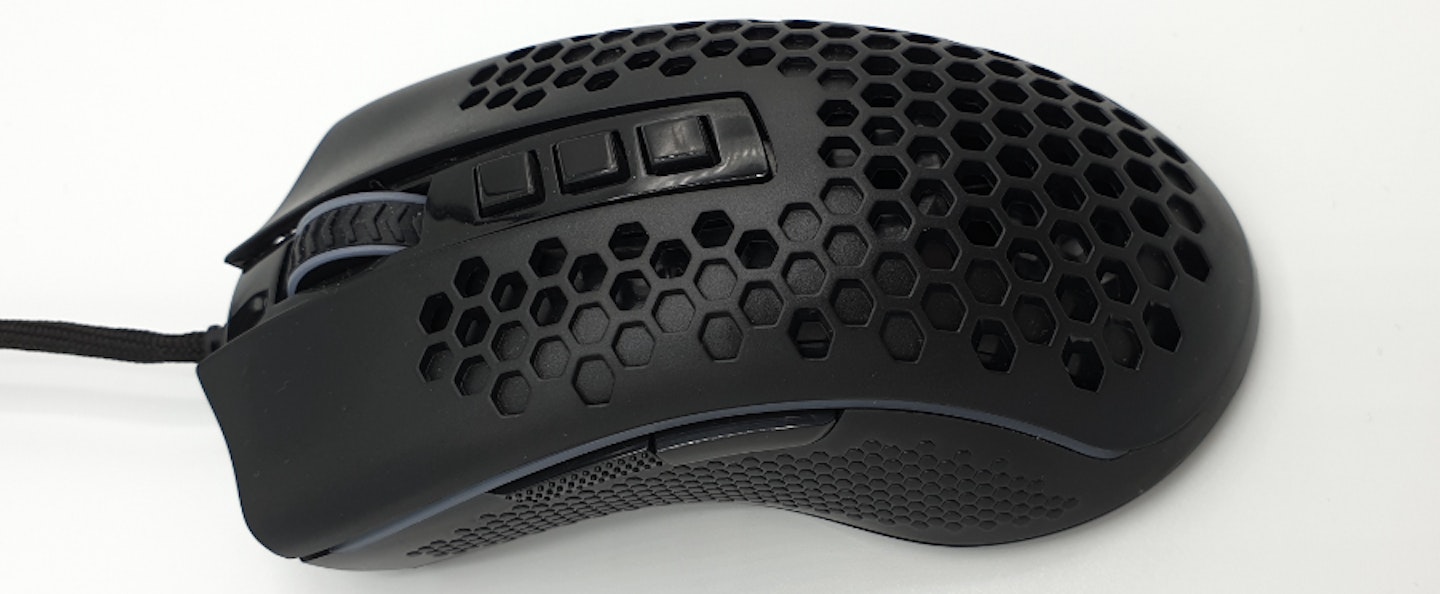The Redragon M808 Storm Honeycomb is an affordable gaming mouse with a compelling list of features, including a 12,400 DPI sensor, customisable button bindings, lightweight honeycomb shell and RGB lighting. At roughly half the price of its premium brand competitors, the Redragon's budget mouse could be a real steal. What’s The Best’s William Lobley puts it to the test.
Note: This review was originally published in February 2021.

The Review
Out of the box, the Redragon M808 Storm seems promising. It’s a good-looking mouse that instantly brings to mind the design principles at work in the SteelSeries Aerox 3 and HyperX Pulsefire Haste, and echoes of the Razer DeathAdder V2 are clear in its slight flaring form.
The honeycomb design, sometimes referred to as hex, is a common sight, and while it does add an edge to a mouse's looks, its primary function is to reduce weight. Usually, you would expect a honeycomb mouse to weigh under 60g, but Storm weighs in at a rather chunky 89g. That number sees it come closer to mice like the Razer Basilisk V2 - a much larger mouse carrying far more tech. With the Storm, Redragon has chased the look rather than the function.

Related: Endgame XM1 Esports Mouse Review | The best gaming mouse mate
Though a little on the heavy side, the skids on its underside help the Storm slide without trouble over a smooth desk mat. There’s no drag from the braided cable either, which is long and lightweight.
The button layout is a standard right-handed configuration (sorry, lefties) with main left/right buttons, clickable scroll wheel and side-mounted forward/back thumb buttons. Underneath the scroll wheel, there are three buttons. The two top buttons are for scrolling through the default DPI modes, while the third is for switching between the seven lighting modes.
All of the buttons have a pleasant click and feel to them, with no dead or unresponsive corners or borders. The forward button on the side has a dotted surface, while the back button is smooth. This works as a great little tactile reminder of where your fingers are in the heat of battle. The scroll wheel also has a raised grip on its rubberised surface.

The body is split into two parts - the matte top plastic and a glossy plastic around the sides, scroll wheel and DPI buttons. The matte plastic feels good in the hand, with a subtle texture that’s nice to touch. Sadly, the glossy plastic only serves as a reminder that the Storm is a budget mouse - it feels very plasticky and is a tad slippery, despite some raised texturing. Redragon could've avoided this issue by using the matte surface across the sides or by using a rubberised grip similar to that used on the scroll wheel. It’s a shame because the buttons, wheel and topside plastic feel great.
The Storm is plug-and-play, with all the default functions working without the need for any additional software. Those who want to take a little more control over their mouse will need to manually download the software as a ZIP file from the Redragon site. It’s a quick and easy process, and the software itself is well presented if a little dated compared to Logitech G-Hub and Corsair iCue suites.

Related: Redragon K530 Draconic 60% Mechanical Gaming Keyboard Review
The software’s RGB light controls boil down to speed and brightness sliders, with the Breathing, Flash and Full Lighted providing additional colour selection. The software is also the place to visit to alter the default DPI modes. Here you can modify mouse sensitivity via a slider ranging from 200 to 12,400, set the polling rate between 125Hz and 1kHz, and increase or decrease scroll speed.
Button mapping is customisable across ten keys, which includes the up and down scrolls. A range of commands can be assigned, including functions like program launches, play/pause and window switching, through to more personal in-game functions like Sniper DPI mode or custom macro commands (set via the in-software macro manager). For those who like to get really granular, polling rate +/- keys are also assignable.
Via the User Mode feature, five sets of five custom DPI, button and RGB presets can be stored for future access. So, you can have five unique mouse setups, including light modes, DPI presets and button assignments, each tuned to a specific task or gaming style. Outside of the software, User Modes are selected via a button on the Storm's underside - it’s the only one that you can't remap.

Related: Redragon Kumara K552 TKL Mechanical Gaming Keyboard Review
While my tastes are pretty vanilla, sticking around 3,000DPI with a default button layout come rain or shine, the flexibility and software offering is going to speak to those who enjoy getting into the specifics of their setups. Though the software is a little clunky in places, in the end, I was impressed at the feature set given the budget price tag on the Storm.
The Redragon M808 Storm is a great way for PC gaming newcomers to explore the functions and advantages of DPI customisation and in-game macro application, with a software package that’s easy to understand and master, even if it’s a little behind the times. It's also a mouse that can serve as a backup or placeholder for more experienced players, too, with a capable sensor and smooth surface flow. The hex honeycomb is more statement than function, but it certainly doesn’t look like a sub-£35 offering. All in all, this is a decent entry-level gaming mouse.

Pros: Good feature set for entry-level experimenting, nice buttons and light cable.
Cons: Some elements feel plasticky, heavy and dated software.
William Lobley is a Content Writer and reviewer for What's The Best, specialising in technology, gaming, and outdoors. He also writes for Empire Online.
